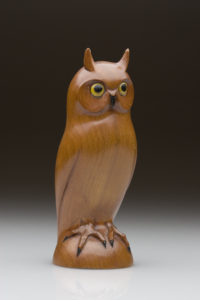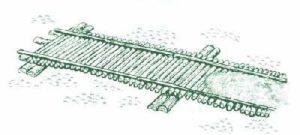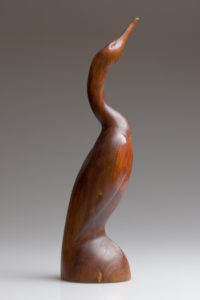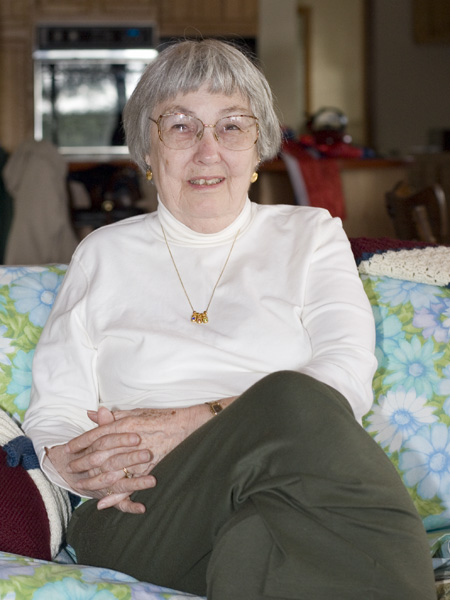Gladys Whitney, Tuckaway Shores, Interviewed by Jeff Gurrier
How did you come to live on Pawtuckaway Lake?
I am related to the Brustle family who were one of the first families here on the lake. Martha Brustle was my aunt, my mother’s sister. My father met my mother at night school in Dorchester. They were learning to speak English. They had just emigrated from Germany. Once you had a member of your family over in America then they could sponsor someone else to come over too. My mother sponsored my Aunt Martha to come over and also her brother. Her brother became an alcoholic during prohibition and the sisters shipped him back to his parents in Germany, which was a very sad thing for them.
So, my parents married, had me, and then my mother died when I was two years old. My father didn’t know what to do with a two year old, so he shipped me back to Germany to live with my grandparents. Then he remarried a year later and they shipped me back to America again.
I was the Brustles’ only blood relative in America, they wanted to keep this place in the family. About 20 years ago Martha sold me the property. Later we discovered that she had left it to me in her will but had forgotten she had done that. It all worked out in the end.
Was Hans Brustle an immigrant also?
Yes, they all came to America from Germany sometime between 1922 and 1926, after the First World War. They left because there was a real food shortage in Germany. Those people were literally starving to death. So, their families sent them over to America so they could survive. They ended up in Boston.
Back then there were Polish Clubs, Italian Clubs, and Irish Clubs in Boston. Well, there was a German Club, too. My father met the Sachses, Meindls, and Brustles at that club. They all belonged to the same club in Boston. They had a lot in common.

They were all wood carvers from Germany. Hans Brustle carved individual artistic pieces.
Edgar Sachs did carvings for churches, ecclesiastical pieces. Peter Meindl did cigar store Indians and that sort of thing. They each had their own niche. So, they didn’t interfere with each other, they had different customers.
If you go to St. Paul’s School in Concord, go into the Chapel, on the left side all of the walls are wood. All of the carvings on the walls there are Hans’s. All the names of all the graduates by year were carved into the walls. It’s quite a work of art. Also, the Raymond Historical Society has a pair of quails that he carved; you can see them there.
How did they end up on Pawtuckaway Lake?
They would just drive around looking; they wanted to find a place where they could be isolated, be alone, and be artistic. I don’t know which one found Pawtuckaway but, one of them did and the rest thought it was wonderful and came along, too. They all bought property up here at the same time. They built the first houses on the South side of the lake.
When they found the property they sought out the owner, worked out a deal, and bought it. I think that was Fred Hartwell. The Hartwells were happy to sell it; it was pretty deserted here back then. I think they paid 50 cents an acre. There were no roads here. You couldn’t even get to the land without walking through the woods. It was considered pretty worthless. And, back then people really needed the money, it was the Depression.
They had to deal with some property line issues from those years. The early surveying in many parts of the lake was a little off. Surveying nowadays is more accurate. Back then, I’m talking way back, when they measured a lot they would walk it out. If the lot was hilly, well they would be going up and down while they were measuring. That will give you a completely different distance than just measuring straight across. You take that down and up and straighten it out and you will end up with a very different number. That kind of thing happened; it caused some trouble.
How did they get up to Pawtuckaway from Boston?
There used to be a railroad that came into Raymond. I don’t know if they came up by train or not. But most of them had a car. My aunt and uncle must have had a car because when they first got married they went out and toured all of the National Parks around the country for two years. They were camping; they had a huge tent. Back then you could stay in the parks and live off of the land. He would do some carving and she would do some housecleaning to make ends meet. They would save up enough cash to buy gas and some groceries and they would be off to the next Park. They lived like gypsies for a couple of years.
When did the Brustles first come up to Pawtuckaway?
In the 1930’s my Uncle Hans purchased all of the land from near Dolloff Dam all the way around to where Meindl Way is now. The original camp they built is off of what is now Meindl Way. It was a little 12×12 shack. They lived in that camp for a whole year. It was the Depression and no one had jobs. They actually survived in that shack for a whole year living off of the land. They picked berries and they would shoot a deer, even out of season, because they needed the food to live on. The wildlife officers knew they needed the food so they just let them do it. And, then later they got jobs again.
They also built a guest cottage, the next house over, that I stayed in when I came up to visit as a girl. The guest house could sleep six. There were two built-in double beds and out on the porch there was another bed that could be pulled out. The kitchen was tiny, there was a sink and a little stove. It has been added onto and made into a year round home. It’s the house with all of the stone walls around it. Then in 1957, after the State decided to build the Park, they built this house on Tuckaway Shores.
Hans built all of the camps himself. He bought some of the lumber in Raymond, but he also bought supplies at the old lumber mill in Fremont. They started to make barrels there at some point. Just past the Fremont Pizza place.
I remember that they lived in Raymond a few different times for health reasons. Martha got sick and their camp was too primitive for her to live in so they would rent a place in Raymond. But they always moved back. They got involved more with things in Raymond, there wasn’t anything going on at the lake or even in Nottingham. Hans belonged to the Grange, Martha belonged to the Raymond Flower Club. Martha would have the Flower Club out here occasionally and they would work on rock gardens.
They went to Church in Raymond, the church that has been having the chicken BBQ every year. They’ve had that BBQ for the last 47 years. I’ve always gone to the chicken BBQ. When I lived in Derry we would come up for that. In fact, when I lived out west, I’d time vacations to coincide with that BBQ.
Did the Meindls and Sachses build at the same time?
Yes, they all built around the same time. Everything had to be brought across the lake by rowboat, every board, every nail. We didn’t have powerboats then, only rowboats.
When Sachses were building their place he talked all of the Germans down at that club in Boston to come up and dig a ditch around it so that his house would be on an island. He always wanted to live on an island. My father had come up to help him with that. He said it was miserable, it was burning hot and the mosquitoes were horrendous. But they supplied these guys with enough beer to keep them all happy. Old man Sachs did that.
I had heard for years that there was a baby grand piano at the bottom of this lake. Finally one day I asked Werner Sachs if he had ever heard this story. He said he didn’t know how that rumor got started but he knew the real story. His father had bought a little spinet piano and he wanted it up here in his camp. They would have lots of fun playing their mandolins, piano, and having wonderful beer parties. Werner was old enough to row a boat by himself. So they waited for a very calm day and he rowed two boats over to the dam. They laid the piano down on one rowboat and tied it to the other. Werner towed the piano across the lake and got it to their camp. When they got it inside it was really out of tune!
You know it’s funny, all of these Germans up here would be trying to save their clothes; they’d be working up here in the nude. There wasn’t anyone else up here. There was one guy on the North side of the lake with a seaplane who’d fly low over here to sneak a peek. Well one day he wasn’t watching where he was going and got tangled up in some telephone lines.
Werner Sachs told me about a time when he was a teenager coming down to the Brustles to pick up his father and those three old Germans were sitting on the wall buck-naked, fishing. He said, “that’s a sight to see!” They had signs out on the road that said, “Toot your Horn” so that everyone could run for cover.
When did you first come to Pawtuckaway?
I came up to visit my aunt as a young girl. We would drive up from Braintree, Mass. My parents lived there most all of my life. I came up for day trips with my parents but when I came up without them I’d stay for a week. That was around the mid 1930’s. When I came up for a week I would bring a girlfriend with me because there wasn’t much to do but swim, fish, pick blueberries and blackberries. We drove up in an old Ford. You would park it over by Dolloff Dam, which was the only road on the lake at the time. The power company had built it to service the dam. None of the other roads were built yet, at least on this side of the lake.
When we got here we’d have to stand on the dam and wave a white handkerchief. The Sachses, Brustles, and Meindls would get out their binoculars and take a look to see if they recognized the people standing there at the dam. If they recognized you, they would come down with a rowboat, pick you up, and row you back to their place. This is the way we came up here back then. There was no other way.
There was a house that was built right on top of Dolloff Dam back then. There was a fellow who lived there who used to put a fishing line right out of his window and fish. That place was torn down a long time ago.
Of course there were no phones, no electricity, nothing. You always came with enough food to feed yourself because there was no refrigeration. You could only keep so much food. There was a trap door in the dining room floor that lifted up. Underneath they had dug out a space in the dirt and put shelves in. It was cool down there and the food would keep longer.
When was Brustle Road built?
Hans built this road himself, he started right away and worked on it steadily over the years. It’s a mile out to Mountain Road and Hans’s property didn’t reach all the way. Hans and Peter Meindl bought 3 or 4 acres at the entrance from Mountain Road so they could be sure not to be cut off from the main road. There was a logging road on that land that went part way down to the lake. They connected up to that to make the road.

All of that land had been completely logged off back then; what’s there now is second or third growth forest. It took awhile to get the road cleared down to the lake. They’d drive down as far as they could and just keep working on it until they eventually got down to the lake. Hans had to build corduroy road over the water sections. He felled trees every spring so that you could get over the places that were really wet. Fortunately, cars were higher then so you could make it all the way in and back out again.
When did Hans start the Tuckaway Shores development?
The Tuckaway Shores development began in the late 1950’s. When the State purchased the land for the State Park they began to leave the water in the lake during the summer. Before that this lake could be empty in August. That is when my uncle decided to subdivide some of his land to form Tuckaway Shores. He also decided to build his new house over here. Then he built three of the cottages on the back lots. This house had such a fantastic well that he supplied water to those three cottages for ten years. They have since put their own wells in. But there is still a 2 inch black rubber hose underground running to those houses.
There was a road down to the lake by then so you could get equipment here to dig a well. In their old camp there was no way to get equipment in. They had to dig that well by hand. You had to lower a bucket down the well to get water. After a while they put a hand pump in the sink. Indoor running water was fabulous. You still had outdoor toilets but they had indoor running water!
Dolloff Dam had been a source of power for mills down the line and eventually the mills found another source of power. So, they didn’t need the waterpower from the lake anymore. The power company put the land around the lake up for bid. My uncle bid on the some of the land that was up for sale and won the bid for the peninsula that is now Lakeview Drive. There weren’t any houses or camps on the peninsula back then. It was just land. Hans had it surveyed and wrote up a plot plan. He eventually sold all of that off.
There was still a big chunk of land left up for grabs. Hans Brustle, Jon White’s grandfather, and Judge Grinnell went up to the State and encouraged them to take that land for a State Park. They kept working that until the State eventually bought the land. Judge Grinnell was a district court judge in Derry, he had some clout. He was a big part of getting the State Park through up in Concord.
The State didn’t want to build the Park. You need to remember that not even the main road was in very good shape. It took a number of years for the State to make a decision. They initially wanted a summer and a winter park, camping and skiing. The State folks would come down and look at all those huge boulders and worry.
Those boulders are actually quite unique. Pawtuckaway and a place up in northern Minnesota are the only two places in the country with a collection of those particular types of boulders. The State didn’t realize that then. They thought they were going to have to do a lot of dynamiting to get rid of those boulders to make room for a ski area. Once it became clear that they were beginning to back out of the plan, the people on the lake encouraged them to try just a summer park. That whole process took almost 10 years.
I think the winter park idea fell through because it was going to take too much money. They were planning a hostel or a small hotel, because you need places for people to stay. Raymond doesn’t have any hotels. So, they would have had to build something in the Park. That was too risky, too much money going into it and they didn’t know for sure if it would work.
I think it is an interesting State Park. They have all these little bridges and the picnic areas are really nice. There is a nice beach and nice camping areas. The individual areas are all spread out and separated from each other. And, they have plenty of parking. It took awhile for them to design it but they did a nice job.
Did the Brustles stay on the lake all year?

My uncle eventually bought a place in Florida and they would spend winters down there and summers up here. Once they got more into real estate they did better; the carving was a hard living. They bought some land down in Florida right after World War II. They had that big tent from their honeymoon trip to the National Parks and they would put that up on their land and camp. They let you do that kind of thing back then. You really couldn’t even find building supplies because of the war. Eventually they had saved enough money to build a house down there.
In Florida he got involved with a bank and they would have one-man art exhibits of his work and he would sell a lot of artwork. He sold more artwork in Florida than he did up here. People in Raymond and Epping at that time didn’t have money for art. They did in Florida.
Has the wildlife changed since you were here as a child?
The wildlife is pretty much the same now as it was when I used to come up as a girl. There were deer, loons, and rabbits. I once saw a deer floating by on an ice flow; how it got on it I don’t know. The deer was on a piece of ice and the wind was blowing it across the lake. The next day there wasn’t any ice on the lake, that’s how thin that piece of ice must have been. The deer looked absolutely terrified wondering what was going to happen. I called my friend Joanne down by the dam to tell her to keep an eye out for the deer floating by.
I’ve seen a fox walk across the ice one year. Of course, we have raccoons. I have a barrel out on the deck with bird seed in it, and they always find ways of getting into that.
What do you think are the biggest challenges facing the lake in the future?
The biggest challenge in the future is going to be the weeds; they are going to keep on spreading. They have really grown a ton since I first started coming up here The lake isn’t that deep and all the boat traffic is spreading them around. All the boats in Fundy are chopping pieces of weeds off and the wind and boats are spreading them around the lake. Luckily we don’t have any exotic weeds like milfoil.
The Park actually makes a lot of money for the State. It has always been profitable and they have never had to advertise it. I think the State could afford to do a little bit more for the lake than they have. Firstly, they should have a boat warden to control the boat traffic; it’s the State boat ramps that are introducing all the extra boat traffic onto the lake. They should be doing more to control the spread of weeds on the lake. The boat launch up in Fundy is full of weeds and all of the boat traffic up there is chewing up the weeds and they are spreading to the rest of the lake. It’s getting bad. We never used to have these weeds down on this end of the lake.
What kind of plants have you had success growing in your garden?
First thing, don’t put in a lawn; leave it as natural as possible. I’ve had a few trees cut down to bring in some sun but we left the roots in to hold the soil. You don’t have to remove many trees to create a view and leaving it natural gives you some privacy, too. If you need to thin out trees, leave the small ones, and clear the old large ones. That will leave more light for the smaller plants and vegetation to grow.
Hostas grow fine, that’s the easiest thing. Iris grow fine. I have a lot of bulbs, daffodils and tulips. I’ve had very good luck with forsythia, rhododendrons, and azaleas. White azaleas don’t do well here for some reason; well, we’re kind of borderline for azaleas up here anyway. Wild blueberries grow fine down on the shoreline. The little ground blueberry bushes are always loaded with blueberries. The high bush ones do well too. The kids come and pick those every Fourth of July. Martha used to go around in her canoe to all of the islands to pick blueberries.
Is there anything else you’d like people to know?
There is a little memorial down at the “Y” in the road, that’s for Palmer Hurd. There was a neighbor who never really knew her father and Palmer Hurd was kind of a father to her. She considered him a father to her anyway. So, when he died she built the memorial to him. He’s not buried there, he was cremated and his ashes were scattered on property that he owned. He sold his place to Betty Butler when he moved over to a place on Meindl’s Way.
That reminds me, there was a story that Betty had caught a raccoon one day and served up raccoon meatballs. There were some people a little upset that she would go ahead and serve them without telling anyone what they were. Betty utilized everything, she was a real frontier-type woman, didn’t let anything go to waste. And, she was a fabulous cook. You just never knew what the meatballs were made of!
Also, I know people are concerned that Dolloff Dam has a leak, the Dam people have looked at it several times because of calls people have made. There is a crack in the rock ledge that the dam is built on. Water seeps through that crack. It has always leaked through that crack. I don’t worry because that big ledge isn’t going anywhere.
